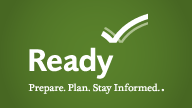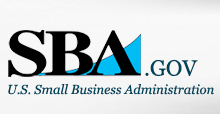Disaster Preparedness
The Government Technology & Services Coalition (GTSC) works to help prepare its members for disasters and encourages small and midsize bsuiness owners to take the necessary steps to make sure their employees, data, location, and other business resources are secure. Now, not later, is the best time to prepare!
Small Business Disaster Preparedness Resources
 Ready.gov – The Federal Emergency Management Agency’s (FEMA) Ready.gov offers business owners the resources to do program management, planning, implementation, testing and exercises and program improvement for emergency preparedness.
Ready.gov – The Federal Emergency Management Agency’s (FEMA) Ready.gov offers business owners the resources to do program management, planning, implementation, testing and exercises and program improvement for emergency preparedness.
FEMA also offers a Business Continuity Planning Suite. This software was created for any business with the need to create, improve, or update its business continuity plan. The Suite is scalable for optimal use by organizations of any size and consists of a business continuity plan (BCP) training, automated BCP and disaster recovery plan (DRP) generators, and a self-directed exercise for testing an implemented BCP. Businesses can utilize this solution to maintain normal operations and provide resilience during a disruption.
 American Red Cross – The American Red Cross Ready Rating program is a free, self-guided program designed to help businesses, organizations and schools become better prepared for emergencies. Members complete a 123-point self assessment of their level of preparedness and have access to tools, tips and best practices to help improve their level of preparedness. The 123 Assessment has been aligned with the federal government’s Private Sector Preparedness standards (PS-Prep).
American Red Cross – The American Red Cross Ready Rating program is a free, self-guided program designed to help businesses, organizations and schools become better prepared for emergencies. Members complete a 123-point self assessment of their level of preparedness and have access to tools, tips and best practices to help improve their level of preparedness. The 123 Assessment has been aligned with the federal government’s Private Sector Preparedness standards (PS-Prep).
 Small Business Administration – The U.S. Small Business Administration (SBA) provides loans to homeowners, renters, businesses and most private, non-profit organizations to repair or replace real estate, personal property, equipment and business assets that have been damaged in a disaster. Any business or private, nonprofit organization that is located in a declared disaster area and has incurred damage during the disaster may apply for a loan to help replace damaged property or restore it to the condition it was in before the disaster. If your business or private, nonprofit organization – large or small – has suffered physical damage as a result of a disaster, you may be eligible for financial assistance from the Small Business Administration. SBA makes physical disaster loans of up to $2 million to qualified businesses or private, nonprofit organizations. For more information, click here.
Small Business Administration – The U.S. Small Business Administration (SBA) provides loans to homeowners, renters, businesses and most private, non-profit organizations to repair or replace real estate, personal property, equipment and business assets that have been damaged in a disaster. Any business or private, nonprofit organization that is located in a declared disaster area and has incurred damage during the disaster may apply for a loan to help replace damaged property or restore it to the condition it was in before the disaster. If your business or private, nonprofit organization – large or small – has suffered physical damage as a result of a disaster, you may be eligible for financial assistance from the Small Business Administration. SBA makes physical disaster loans of up to $2 million to qualified businesses or private, nonprofit organizations. For more information, click here.
Citizen Training
The Federal Bureau of Invesigation Citizens’ Academy
Community Emergency Response Team – The Federal Emergency Management Agency’s (FEMA) Community Emergency Response Team (CERT) Program educates people about disaster preparedness for hazards that may impact their area and trains them in basic disaster response skills, such as fire safety, light search and rescue, team organization, and disaster medical operations. Using the training learned in the classroom and during exercises, CERT members can assist others in their neighborhood or workplace following an event when professional responders are not immediately available to help. CERT members also are encouraged to support emergency response agencies by taking a more active role in emergency preparedness projects in their community. Join one of 2,200 nation-wide programs!
National Citizen Police Academy Association
Mobile Apps
American Red Cross offers the following mobile apps. >>Learn More
- First Aid
- Tornado App
- Hurricane Appe
- Shelter Finder App
- Earthquake App
- Wildfire App
- Team Red Cross: Volunteer App
Here are the 5 Essential Steps to Preparedness from the American Red Cross:
1. Commit to preparedness
This step indicates your commitment to increasing your business’ or organization’s level of emergency preparedness during the course of the calendar year. You will be working to make your business or organization more prepared and to enhance overall community preparedness. Key actions for this step include:
- Having your business or organization make preparedness a priority by having senior leadership involved
- Appointing a Ready Rating liaison dedicated to completing the 123 Assessment. See an assessment sample here.
2. Conduct a Hazard Vulnerability Assessment
This step involves gathering information about possible emergencies that could impact your business and your facility’s capabilities to respond to and recover from a disaster or other emergency. Key actions for this step include:
- Knowing your region and the types of disasters most likely to impact your business
- Obtaining a Hazard Vulnerability Assessment from your local emergency management agency
- Considering which hazards your facility is most likely to experience, based on proximity and past events
- Knowing your business or organization’s current capacity to prepare for, respond to and recover from a disaster
- Assessing the physical capacity, supplies, equipment and human resources of your facility to resist damage during a disaster
3. Develop an emergency response plan
An emergency response plan describes the steps your business or organization will take to protect your business and employees before, during and after an emergency. Key actions for this step include:
- Identifying an emergency planning committee that is responsible for developing and implementing an emergency response plan
- Developing a written plan describing how your business or organization will respond during a disaster or medical emergency
- Creating a Continuity of Operations Plan (COOP)
4. Implement your emergency response plan
This step involves continuing to work with the planning committee to implement the emergency response plan with employees. The key to implementing the plan is to make preparedness a part of the corporate culture. Key actions for this step include:
- Training employees on a regular basis about what to do during a disaster or emergency
- Acquiring and maintaining needed safety equipment and emergency preparedness supplies
- Showing employees how to be prepared at work and at home so they are better equipped to help the business respond to and recover from an emergency
- Conducting and assessing regular drills and exercises to determine the readiness of your employees and facilities
5. Help your community get prepared
Now that your company and employees are prepared, make at least one additional commitment to ensure that the overall community is prepared for a disaster or other emergency. Key actions for this step include:
- Hosting blood drives
- Contributing supplies and/or services to emergency response efforts
- Adopting a local school or school district and support their disaster and emergency preparedness programs

